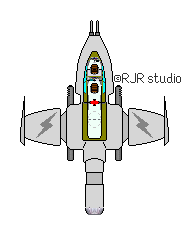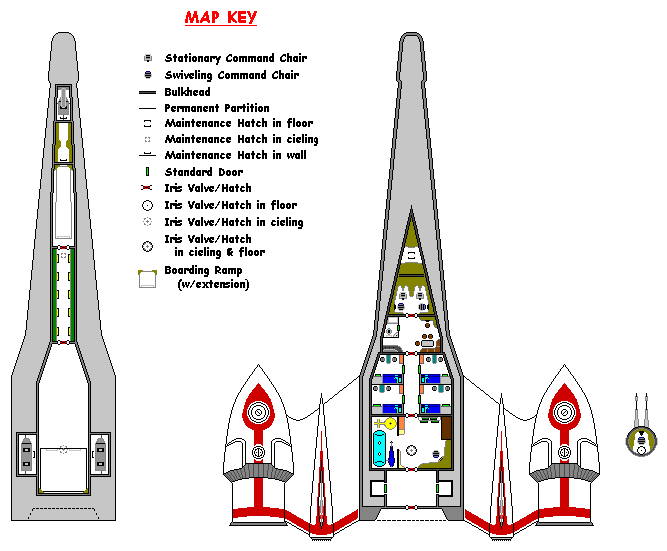Parallel to main axis plans
This section will house non-conventional KH type deckplans, such as those found in other "cinematic" genres such as Star Trek, Star Wars, or Traveller. Such craft, when equipped with chemical drives, make for fine system ship deck plans.
MRX-8
--- work in progress ---
pf-100 era scout ship
HS:2 HP:10 Powerplant: 3 Chemical A
ADF:3 MR:4 DCR:16 Crew: up to 2
Armament: optional LC (mark 1) @ -1 ADF or MR penalty
Defenses: optional RH
Communication/Detection: Subspace Radio, Radar, Intercom
Misc: Streamlined
Computer
Alarm (3)
Analysis (2)
Astrogation (2)
Commerce (1)
Computer Lockout (3)
Computer Security (3)
Damage Control (3)
Drive, Chemical A (1)
Information Storage (1)
Life Support, cap:2 (1)
Maintenance (3)
Cargo Capacity: personal gear
Crew Accomodations: 1 two-bunk cabin
Passenger Accomodations: 0
Ship's Vehicles: 0
The MRX-8 scout ship saw extensive service as a survey & research vessel during the first corporate war. The small craft would ferry two crew members around the system on their various prospecting missions. Some of these vessels were pressed into spy missions against the Mining Guild, equipped with surveillance equipment and prototype sensor jammers developed by Streel, hence the rebadging as a scout ship.
* Adapted from the WEG Star Wars RPG system
Aquilian Starling
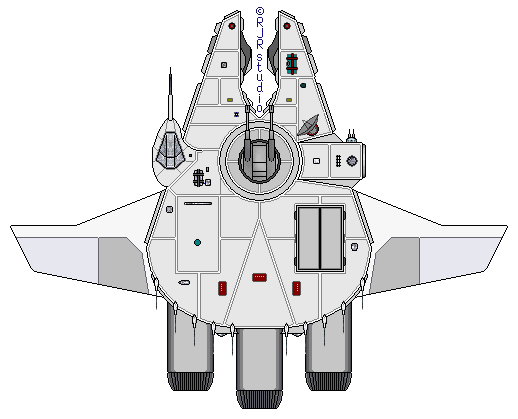
HS:4 HP:24 Powerplant: 3 SC Chemical A
ADF:4 MR:4 DCR:25 Crew: 3-8
Armament: LB(x2)
Defenses: RH
Comm/Detection: SubSpace Radio, Radar, Intercom, WNB
Misc Equipment: Streamlined, Light Armor, Back-up LS unit, Mk-X5 fuel tankage
COMPUTER ( LVL:6 fp:237 Mass/SP:1000kg/600 )
Alarm (3) 8
Analysis (3) 8
Astrogation (2) 8
Bureaucracy (3) 12
Commerce (1) 4
Communication (1) 4
Computer Lockout (5) 32
Computer Security (4) 24
Damage Control (3) 12
Drive - Chem A (1) 4
Industry (1) 4
Information Storage (1) 3
Installation Security (5) 64
Laser Battery x2 (1) 2 x 5
Life Support cap:8, x2 (1) 2 x 2
Maintenance (3) 12
Robot Management (4) 24
Cargo Capacity: 2 (Main:1.25, Forward: 0.25, Aft: 0.5)
Crew Accomodations: 3 bunk cabin, double suite
Passenger Accomodations: 0
Ship's Vehicles: AWD Ground Car, Ground Cycle
Fuel: 180u S-Ox ( +3 x 12u ExTanks)
Max Safe Velocity: 30 (+6)
The MAIN DECK features a two person helm, 6 person bunk barrack, two person suite, all adjacent to the crew lounge/computer which doubles as the forward hold. A ladderwell runs up to the dorsal gun and down to the main hold & ventral gun. A fresher fills the gap behind the bridge accesway and a shower unit flanks the ladderwell. Fore of the crew lounge are the forward "mandibles" featuring most of the avionics, communication, sensors, and electronics. Aft of the crew lounge is the engine room, with RCS thruster banks, generator & power relay station, life support equipment (including water tank and purification plant) and work stations. Starboard of the lounge is the cargo loading dock and boarding ramp, along with a defensive anti-personnel gun. The aft hold is adjacent to the loading dock.
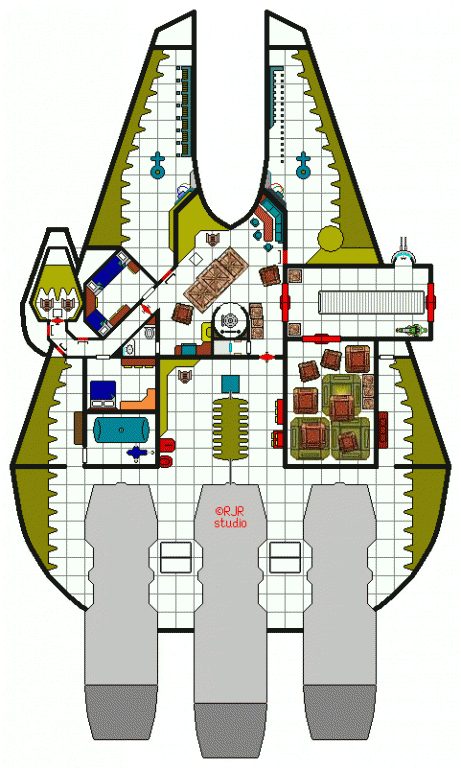
The LOWER DECK is comprised of the main hold w/loading ramp and access to the landing gear. To port is a computer maintenance shaft that connects the main computer to the helm. Below the Main Hold is the ventral gun position.
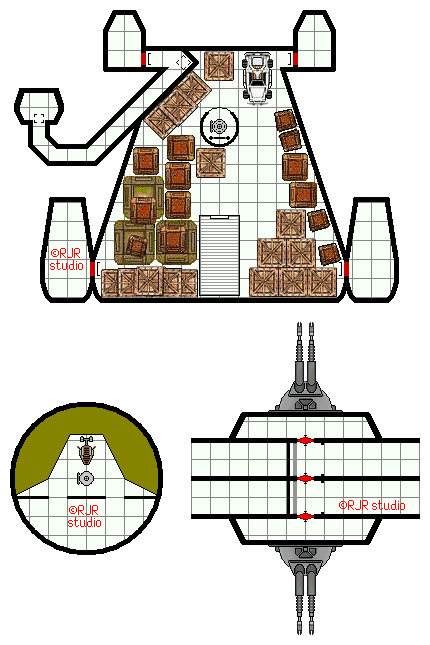
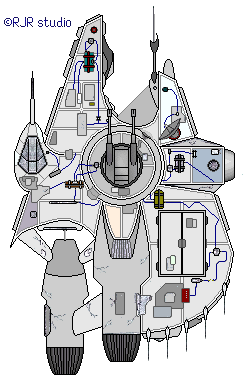
HS: 3* HP: 18 Powerplant: 3 Pan-Galactic "Eureka" Atomic A
ADF: 5 MR: 3 DCR: 32 Crew: 2, can accomodate up to 9
Armament: LB (x2)
Defenses: RH
Communication/Detection: SubSpace Radio, Radar, Energy Sensor, Intercom
Misc Equipment: Light Hull Armor, Skin Sensors, Delux Astro, Camera System, Cybernetic Uplink Slave Circuits
Computer
(LVL: 4 fp: 198 sp:100)
Alarm (3), Analysis (6), Astrogation (4), Bureaucracy (5), Commerce (1), Communication (4), Computer Lockout (6), Computer Security (6), Cyber-link (3), Damage Control (3), Drive (4), Information Storage (3), Installation Security (6), Language (6), Laser Battery (1) x2, Life Support - cap:9 (1) x2, Maintenance (3), Robot Management (6)
Cargo Capacity: 2.5 (0.9 lower hold, 1.6 aft hold)
Fuel Tankage: 9 uranium pellets, 3/drive
Crew Accomodations: 1 double cabin, 1 six-bunk cabin, 1 bunk in rec area
Passenger Accomodations: n/a
Ship's Vehicles: 0
* Actual displacement is HS:3, vessel was reduced by damage/reconstruction from original HS:4
Crew: Richard Sterling (mH) Pilot:3, Engineer:3, "Glasya" Carolina Sterling (cybernetic fH) Pilot:2, Astrogator:2, Engineer:1, Energy Gunner:4 --- Glasya may multi-task via the cyberlink connections, thus operating both battery weapons simultaneously as well as performing co-pilot & astrogator operations and coordinating engineer functions.
The Starling has a rich history, dating back before the founding of the UPF. A young Captain John Knightrazor (formerly Robert Kitridger) acquired it via a government contract co-signed by Streele, Inc. Later the ship required major renovations after a near fatal encounter during the first Sathar War. The ill-fated vessel unknowingly dropped out of the void into a UPF system that the Sathar Battle Fleet had already entered, and the ship took a beating. It would have no doubt been destroyed if not for the timely intervention of Admiral Morgaine's fleet, who arrived and made the unfriendlies feel most unwelcome. The Starling was taken in tow and it's crew began redesigning what they had left to work with.
When the war was officially over the Starling's crew were finally able to secure dock space for the reconstruction. The entire engine compartment had been destroyed, as well as a portion of the forward starboard side. Supplies were short and in demand so rebuilding the missing sections became a timely and costly operation, the crew instead opted for sealing up those sections and relocating the salvageable equipment. The drives were relocated from their original inboard location to an outboard set up, with one drive on both the dorsal and ventral sections of the aft section and the third replacement drive was attached via struts off to the portside, thereby filling in that missing section. All the replacement equipment that was destroyed in the fore section ended up on the port side of the forward hull, making it a nearly impassible area to work in. Jonathan gifted the salvaged vessel to his son Stephen who sold it after nearly ten years of freight hauling in favor of subcontracting a new RT model. It was later re-gifted to Stephen's son Jonathan who sold it to the current owner, adventurer Richard Sterling. Captain Sterling still owns and operates it today, with cyber-slave circuits installed so that Sterling's cyborg/wife could control and operate multiple systems from one location, thus allowing for a reduced crew
.
As a result of the salvage/reconstruction, the actual hull displacement ended up dropping from HS:4 to HS:3, but through clever restructuring of the interior the cargo capacity remained the same, what with the drives being converted to outboard this opened up some extra unused deck space. One additional benefit comes with the smaller size, with Class A drives designed to power a size 4 hull now powering smaller displacement size 3 hull, the ship now performs a little better. In fact current owner Silver has logged some very respectable times in the Zebulon Run with "the Clunker" (as he affectionately calls her). Unfortunately that fame comes with a price for Silver, who prefers to avoid any interstellar attention...

Main Deck

Assault Courier
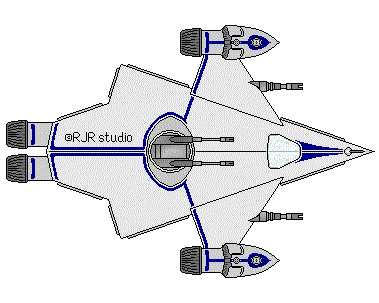
ADF:3 MR:4 DCR:24 Crew: 4-16
Armament: LC(mk1), LT
Defenses: RH
Comm/Detection: SubSpace Radio, Radar, Intercom
Misc Equipment: Streamlined, light hull armor, mk:3 fuel tankage
COMPUTER
Alarm (4)
Analysis (2)
Astrogation (2)
Commerce (1)
Communication (1)
Computer Lockout (3)
Damage Control (4)
Drive - Chem A (1)
Industry (1)
Information Storage (1)
Laser Cannon (1)
Laser Battery (1)
Life Support cap:16 (1)
Maintenance (4)
Cargo Capacity: 0.5
Crew Accomodations: 4 cabin (single or double occupancy), 2 lg cabins (single to quadruple occupancy)
Passenger Accomodations: 0
Ship's Vehicles: varies, ground/atmo vehicle bay
Fuel: 92u S-Ox (+2 x 12u ExTanks)
Max Safe Velocity: 24 (+12)
DECK PLANS
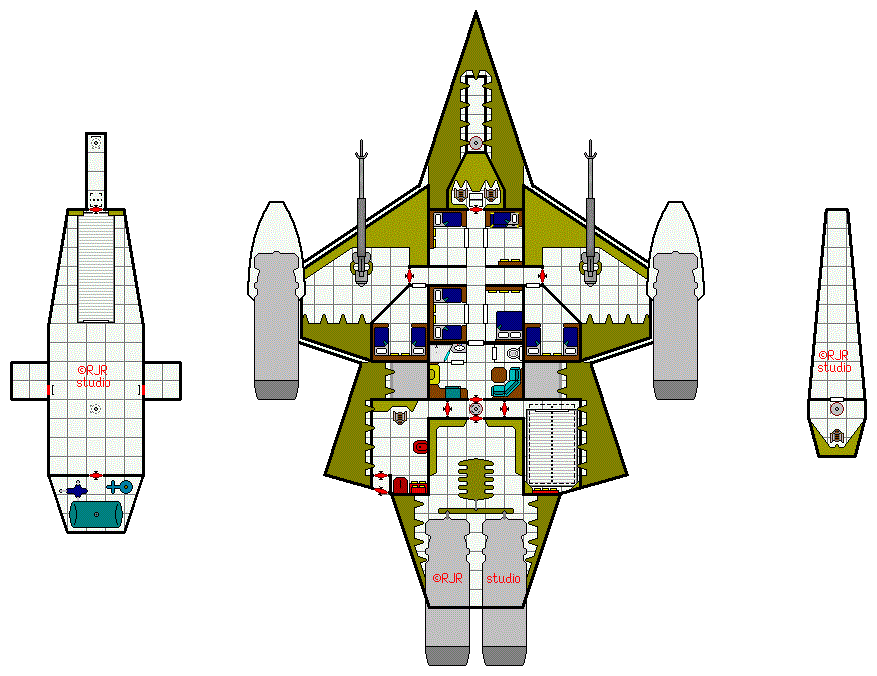
Derived from the tried & true PGC Courier, the SI/C-300 Assault Courier variant is the result of what happens when the Streele, Incorporated military contractors get a hold of the design. Outboard sections flank each side of the craft to which an additional pair of drives have been attached, allowing for a quartet of supercharged Chem-drives which triples the standard Courier's performance ratings. Additional RCS maneuver jets were also added in these new section to increase the nimble nature of these craft. Two more cabins were added in the outboard sections, thereby increasing the possible crew size (these cabins tend to have a pair of bunkbeds to allow for eight troops in addition to the standard crew quarters). Additional flight control equipment is mandated for such performance increases, and this too is packed within these outboard sections.
The rest of the design retains the original donor ship's features: the lower cargo hold & life support, crew lounge area & galley along with the original four cabins, vehicle bay, engineering bay, and equipment storage attic. These warships were not mass produced, seeing service strictly among the Pale & New Pale militias along with Pan Galactic Conglomerates' Mining Guild (although more than one of the Guild's craft were seized by pirates).
Basic Shuttle
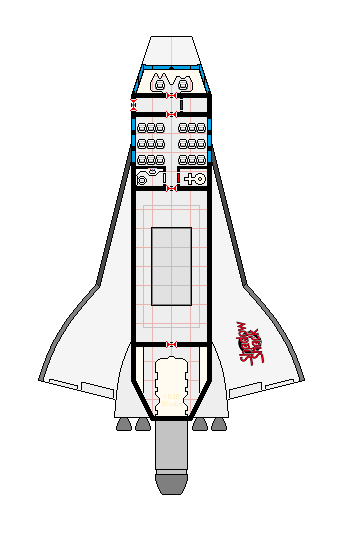
C-37 Courier
ADF:1 MR:4 DCR:24 Crew: up to 4
Armament: optional LT
Defenses: optional RH
Communication/Detection: Subspace Radio, Radar, Intercom
Misc: Streamlined, Light Armor, Mk:x3 Fuel Tankage
Computer
Alarm (2)
Analysis (2)
Astrogation (2)
Commerce (1)
Computer Lockout (3)
Computer Security (3)
Damage Control (2)
Drive, Chemical A (1)
Information Storage (1)
Life Support, cap:6 (1)
Maintenance (2)
Cargo Capacity: 1
Crew Accomodations: 4 single crawl-bunks
Passenger Accomodations: 0
Ship's Vehicles: varies
Fuel Tankage: 72u S-Ox (plus two 12u ExTanks)
Max Speed: 18 (+6)
The C-37 was a fine courier craft offered to the general public during the first corproate war in Truane's Star. Many a civilian crew found fortune with this small ship, running errands for or against the Mining Guild during that dark era. The small craft offered fair quarters and a decent sized hold, although not large enough to be profitable. However, these craft earned a notorious reputation with smugglers who were hiding contraband within the various access plates in the deck and other convenient hidey-holes found throughout the craft...
The C-37's wings and drives rotate 90º on a gimbal to permit VTOL operation...it lifts off the ground like a helicopter and as the drives & wings are angled it begins to move forward like a plane, eventually building enough velocity to break the atmosphere. Planet fall is conducted in the opposite direction: it enters the atmosphere tail first and uses thrust to decelerate, eventually rotating the wings/engines to vertical for a soft landing. The external fuel tanks mount dorsally over the cargo section.
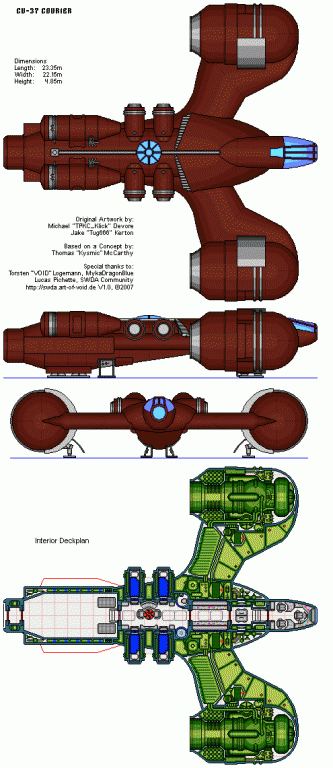
* Adapted from the WEG Star War RPG system
Courier
adapted from the Traveller RPG Scout/Courier
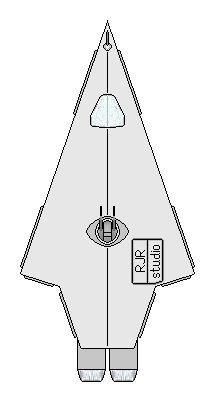
HS:3 HP:15 Powerplant: 2 Chemical A
ADF:1 MR:3 DCR:24 Crew: 3-8
Armament: LT
Defenses: RH
Comm/Detection: SubSpace Radio, Radar, Intercom
Misc Equipment: Streamlined, Mk:X2 Fuel Tankage
COMPUTER
Alarm (2)
Analysis (2)
Astrogation (2)
Commerce (1)
Communication (1)
Computer Lockout (3)
Damage Control (2)
Drive - Chem A (1)
Industry (1)
Information Storage (1)
Laser Battery (1)
Life Support cap:8 (1)
Maintenance (2)
Cargo Capacity: 0.5
Crew Accomodations: 4 cabins, single or double occupancy
Passenger Accomodations: 0
Ship's Vehicles: varies, ground/atmo vehicle bay
Fuel: 48u S-Ox (+ two 12u ExTanks)
Max Safe Velocity: 12 (+6)
DECK PLANS
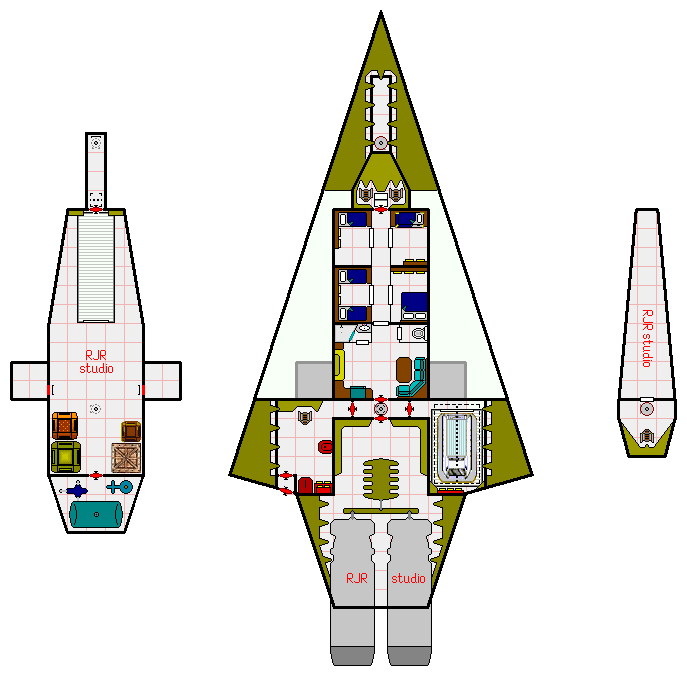
Pan Galactic Conglomerates designed this extremely versatile system ship which has seen use in many systems, and they can still be found in service within systems employing multiple orbital space stations and civilized planets.
The Main Deck (center) has a forward avionics/RCS thruster bank area accessible from below. The bridge also has a maintenance hatch leading below and command chairs for two (a pilot and navigator). Aft of the bridge are four cabins that can be arranged for single or double occupancy as the crew desires. Behind the cabins is the crew lounge with galley, fresher, and washroom. The lounge connects to a four way access chamber with hatches leading port to the engineering section, starboard to the vehicle bay (an open hover transport is depicted), and stern to the engine room. A floor hatch in the center leads to the cargo bay, a cieling hatch leads to the gunnery position above.
The Upper Deck (right) has the gunner position above the vertical hatch with controls for the ship's laser turret. Forward of the gunnery position is an attic containing the sensors and communication equipment.
Fair Trader/Fast Trader
Merchant Vessel (pf:100 system ship)
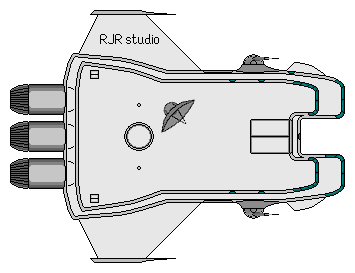
HS: 4 HP: 20 Powerplant: 3 Chemical A (SC for Fast Trader)
ADF: 1(2) MR: 3 DCR: 27 Crew: up to 8
Armament: LT(x2)
Defenses: RH
Communication/Detection: Subspace Radio, Radar
Misc: Streamlined. Mk:X4 Fuel Tankage
COMPUTER
Alarm (3)
Analysis (2)
Astrogation (2)
Commerce (1)
Computer Lockout (3)
Computer Security (3)
Damage Control (3)
Drive, Chemical A (1)
Industry (1)
Laser Battery (1) x2
Life Support, capacity:22 inc 4 1st class (1)
Maintenance (3)
Cargo Capacity: 2.5
Fuel Tankage: 144u S-Ox (+ three 12u ExTanks)
Max Speed: 24 (+6)
Crew Accomodations: Captain's double suite, 3 double cabins
Passenger Accomodations: 2 double 1st Class cabins, 4 double journey class cabins
Ship's Vehicles: small launch
DECK PLANS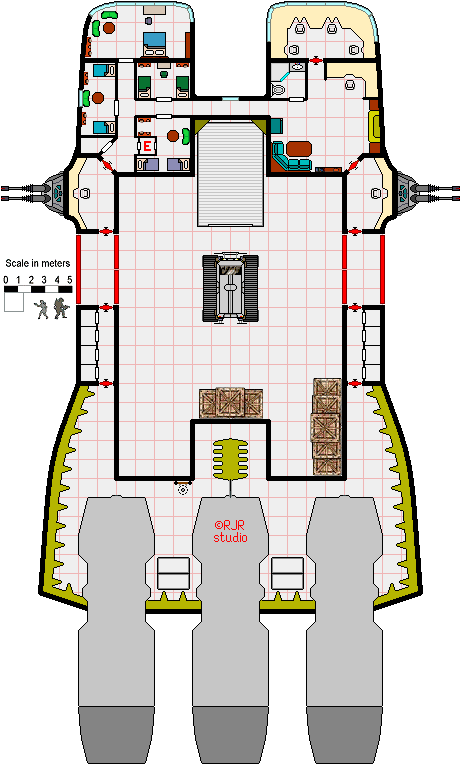
The Main Deck is accessible via the cargo bay, by a loading ramp at the fore and airlocks boasting large bay doors port and starboard. Aft of the airlocks are crew lockers, behind that is the engine room with a generator and RCS thruster banks. Forward of the airlocks are the port and starboard gunnery positions with controls to the ship's two laser turrets. The ship is divided into two parts fore of the guns, the port side sporting three double occupancy crew cabins, elevator to upper deck, and a captain's suite. Located starboard is the crew lounge (with galley, fresher, and shower), computer console, and the bridge.
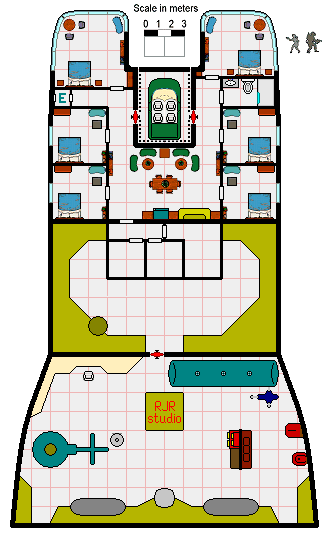
The Upper Deck is divided into three sections. At the fore are the passenger cabins, including a quartet of double occupancy Journey class cabins and a pair of 1st class suites positioned over the bridge and captain's suite. The launch bay divides the cabins port and starboard, aft of the bay is the passenger lounge. A trio of smaller rooms are positioned aft of the lounge that can serve as a variety of functions, normally the two smalelr rooms serve as storage space and the larger as an office. The midsection is comprised of avionics, electronics, and the communication & sensor arrays, all accessible only via the engineering section. Stern is the maintenance deck with the engineer station, life support equipment (including water tank and purification plant), power relay station, and workshop.
adapted from the Traveller RPG "Far Trader"
HWIS Planeteer

ADF:1 (2) MR:4 DCR:24 Crew: up to 4
Armament: optional LT
Defenses: optional RH
Communication/Detection: Subspace Radio, Radar, Intercom
Misc: Streamlined
Computer
Alarm (6)
Analysis (4)
Astrogation (4)
Commerce (1)
Computer Lockout (3)
Computer Security (3)
Damage Control (6)
Drive, Chemical A (1)
Drive, Ion A (3)
Information Storage (1)
Life Support, cap:6 (1) x2
Maintenance (6)
Cargo Capacity: 0.5
Crew Accomodations: 2 double occupancy cabins
Passenger Accomodations: 0
Ship's Vehicles: varies
Fuel Tankage: 72u S-Ox (plus two 36u ExTanks), 20K LiqH
Max Speed: 18 (+18) (chemical drive only, unlimited w/Ion)
This Hepplewhite, Inc. scout ship is an old design predating the UPF, this particular sample has been updated with modern conveniences. Hepplewhite has never been shy about spending credits on their business ventures, and the Planeteer is no exception. Utilizing a pre-UPF design, this pricy vessel sports a pair of Ion star drives in addition to a quartet of chemical thrusters to permit planetary landings. The dated decks-parallel is an inconvenience during jump acceleration, the crew needs to be belted in for the entire accel.deceleration phase and can only travel about during zero-G movement via free fall. However once parked on a planetary surface the decks are naturally simple for such duty. This particular vessel crash landed and was discovered by a group of novice adventurers, the sole survivor of the crew being a Yazirian child.
Pan Galactic Conglomerates Gunned Scout
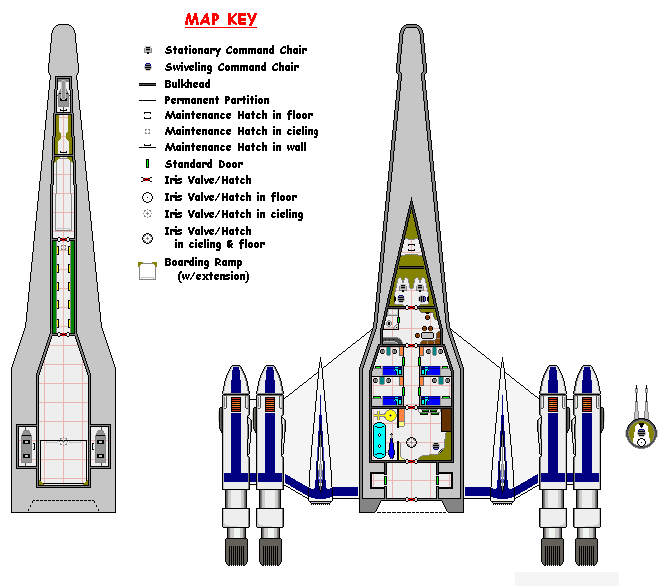
Pirate Scout Ship
system scout ship
HS: 3 HP: 18 Powerplant: 4 SC Chemical A
ADF: 3 MR: 3 DCR: 30 Crew: up to 6
Armament: FFR(x2), LT(x2)
Defenses: RH
Communication/Detection: SubSpace Radio, Radar, Intercom
Misc Equipment: Streamlined, Light Armor
Fuel: 144u S-Ox (+4 x 36 ExTanks)
Max Speed: 18 (+18)
Computer
Alarm (4)
Analysis (2)
Astrogation (2)
Commerce (1)
Communication (1)
Computer Lockout (4)
Computer Security (4)
Damage Control (4)
Drive: Chemical A (1)
Forward Firing Rockets (2)
Industry (1)
Information Storage (1)
Installation Security (4)
Laser Turret (1) x2
Life Support, cap:8 (1)
Maintenance (4)
Cargo Capacity: 0.5
Crew Accomodations: 2 triple bunks
Passenger Accomodations: n/a
Ship's Vehicles: none
Typical example of a pirate craft found during the first corporate war in Truane's Star. Streel captured several of these and revamped them for special missions against the Mining Guild, dropping the forward firing rocket systems in favor of a light laser cannon and extra fuel tankage (and a resulting performance gain).
In their stock guise, the pirate scouts packed a good punch. A pair of laser turrets to disable their target craft were complimented by the rocket systems that would ward off escort craft, and their small holds could carry away some valuables afterwards (although not much, hence these vessels were often encounted in groups of more than one).

*Adapted from the WEG Star Wars RPG system
PT-250 Stratus class transport
(pf:100 era system ship)
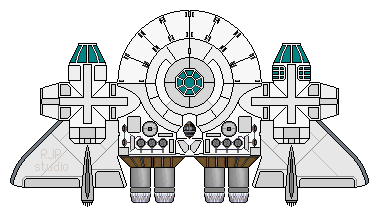
HS:2 HP:14 Powerplant: 4 Chemical A
ADF:3 MR:4 DCR:26 Crew: minimum 2, up to 6
Armament: optional LT(x2) @ -1 ADF or MR each/max:2
Defenses: RH
Communication/Detection: Subspace Radio, Radar, Intercom
Misc: streamlined, medium hull armor, Mk:X4 Fuel Tankage
Fuel Capacity: 192u S-Ox (plus four x 12u ExTanks)
Max Speed: 24 (+6)
COMPUTER
Alarm* (4)
Analysis (2)
Astrogation (2)
Bureaucracy* (2)
Computer LockOut* (3)
Computer Security* (3)
Commerce (1)
Communication (1)
Damage Control* (4)
Drive - Chem A (1)
Life Support, cap:6 (1) +6 Journey class (type P/T) or +8 1st class (type Y)
optional Laser Battery (2) x2
Maintenance* (4)
Cargo Capacity: 1 (type T), 0.5 (type P/T), or 0 (type Y)
Crew Accomodations: 1 dbl suite + 4 single cabins
Passenger Accomodations: 0 (type T) or 3 Journey Class cabins (type P/T) or 4 1st class suites (type Y)
Ship's Vehicles: n/a
DECK PLANS
rendered in 1.5 meter squares
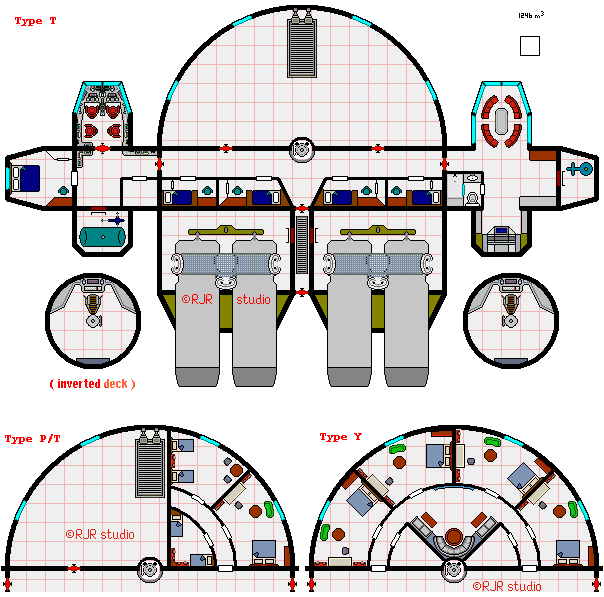
The basic PT-250 Stratus incorporates a disc shaped hull with outboard pods extending port and starboard and drive units positioned aft. The layout is simple and straightforward:
The port pod contains a helm with four command chairs, a two person captain's cabin, a computer room/rec area, a storage closet, and life support equipment. The starboard pod contains a crew galley & rec area, access to the life support equipment, and a fresher. The forward area is an open cargo hold with a loading ramp, aft of the hold is the four single occupancy crew cabins. Aft of the cabins is a narrow hallway with a boarding ramp and outer hull hatch (thus doubling as an airlock), flanked by maintenance panels leading to the port & starboard twin thrusters. Centered in the ship is a ladderwell leading up and down to observation rooms, the ventral chamber is inverted with everything mounted "upside down" in relation to the rest of the ship allowing occupants to look "up" to the stars through the "overhead" viewport. These observation rooms can be easily converted to laser turret hardpoints, with the ventral unit remaining inverted under such construction.
Two variants of the PT-250 can be ordered: the Type Y replaces the forward hold with a quartet of two person suites along with a lounge and storage areas (thus designating it as a yacht). The Type P/T divides the forward hold into a half hold (½ unit capacity) and a trio of two person cabins (two journey class and a suite).
Regardless of variation, smaller crews may opt to offer passage via unused crew cabins.
adapted from the WEG Star Wars RPG
SI/F-432 "Strider" class Light Freighter (work in progress)
(pf:100 era system ship)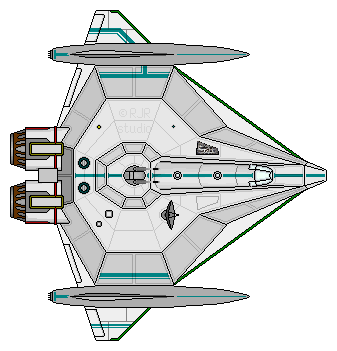
ADF:1 MR:3 DCR:32 Crew: 3-8
Armament: LB
Defenses: RH
Comm/Detection: SubSpace Radio, Radar, Intercom
Misc Equipment: Streamlined, light hull armor, Mk-3 fuel increase
COMPUTER
Alarm (4)
Analysis (2)
Astrogation (2)
Commerce (1)
Communication (1)
Computer Lockout (3)
Damage Control (4)
Drive - Chem A (1)
Industry (1)
Information Storage (1)
Laser Battery (1)
Life Support cap:8 (1)
Maintenance (4)
Cargo Capacity: 3
Crew Accomodations: 4 cabins, single or double occupancy
Passenger Accomodations: 0
Ship's Vehicles: varies, ground/atmo vehicle bay
Fuel: 192u S-Ox (+4 x 12u ExTanks)
Max Safe Velocity: 24 (+12)
When Streele, Incorporated designed the SI/F-432 they did so with the concept of a "space pick-up truck" in mind. As such they went with the size:4 "biggest of the small ship hulls" for maximum scale at a minimum price. Like a pick-up, the cab offers comfort and the cargo bed offers...space for cargo. The Strider class light freighter is no different, it has just enough comfort in the living area while maintaining a dedicated space for hauling anything and everything. Light hull armor makes it tough without impeding performance, which is a far cry from sporty but still respectable for what it is: a simple design dedicated to a simple purpose. That said, anyone wishing to explore the boundaries of performance can always remove the laser battery to restore MR back to 4, but the threat of pirates has captains trending to retain the long range defensive system.
Deck Plans TBA
SI/M-250 Merchant Courier
(pf:100 system ship)
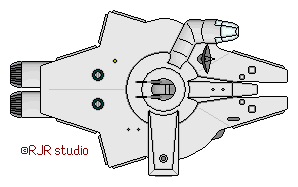
HS:3 HP:15 Powerplant: 2 Chemical A
ADF:1 MR:4 DCR:24 Crew: up to 6
Armament: optional LT (in lieu of upper hold)
Defenses: optional RH
Communication/Detection: Subspace Radio, Radar, Intercom
Misc: Streamlined, Mk:X3 fuel increase
COMPUTER
Alarm (2)
Analysis (2)
Astrogation (2)
Commerce (1)
Computer Lockout (3)
Computer Security (3)
Damage Control (2)
Drive, Chemical A (1)
Information Storage (1)
Life Support, cap:6 (1)
Maintenance (2)
Cargo Capacity: 1.5 (1 main hold + 0.5 forward hold), optional 0.25 upper hold in lieu of turret
Crew Accomodations: 1 dbl suite, 1 two-bunk cabin
Passenger Accomodations: 0
Ship's Vehicles: varies
Fuel Tankage: 72u S-Ox (plus two 12u ExTanks)
Max Speed: 18 (+6)
Streele, Incorporated reverse engineered the classic PGC Courier to create a more trade oriented variant which has been dubbed as a Merchant Courier. While much of the donor ship's DNA has been preserved, everything forward of the engineering & vehicle bays has been revamped. With the base disc shape taking over the former wedge, additional space was permitted for a larger ventral hold. Cutting the point off the nose and splitting it into a pair of "mandibles" mandated moving the helm from center to port side, and said additional disc space opened up some additonal acreage for a secondary hold. While the fore to stern equipment attic was lost, the additional upper deck saucer space allowed for the ease of installation for a turret weapon and fire control, although some owners who trust in the protection offered by the Mining Guild sacraficed this in lieu of additional cargo stowage.
DECK PLANS
The Main Deck commences with a cargo loading dock located starboard, complete with boarding ramp and bay doors. A second set of bay doors leads to the forward hold and access to the starboard electronics/avionics. A hatch fromthe loading dock leads inward to a semi-circular accessway that circles around to a forward communication/sensor array, mainframe computer, and the crew cabin. Access to the port avionics/electronics is near the mainframe. The semi-circular accessway continues around to the portside with access to the bridge and captain's suite, occassionally spotted with other maintenance hatches. The semi-circular accessway terminates at the crew lounge, sporting a galley, fresher/shower room, and a storage room. A ladderwell centered in the lounge leads up to the gunnery position and down to the main hold. A hatch in the stern bulkhead leads to engineering (port), the engine room (stern), and vehicle bay (starboard, open ground transport depicted).
The Lower Deck is comprised mostly of the mainhold and has maintenance access to the landing gear and a hatch leading to the life support equipment (including a water tank and purification plant).
The Upper Deck is a low cieling chamber with controls to the ship's laser turret and a small attic.
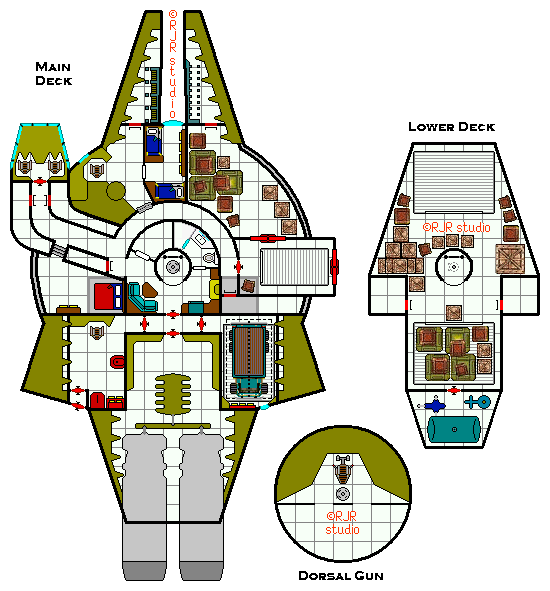
ST-260 light freighter
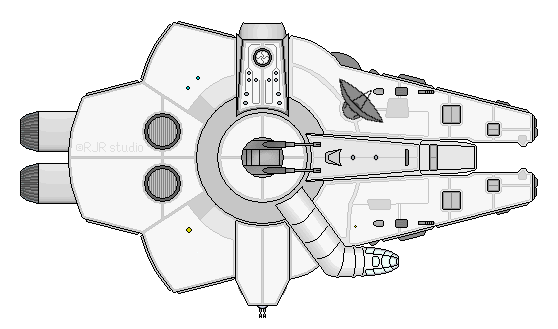
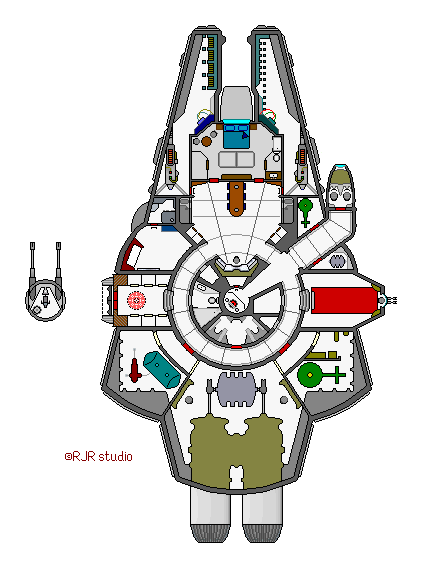
main deck
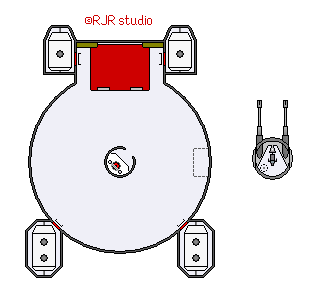
lower deck
ST-2850T Transport
Trans Travel ST-2850T

ST-3000
light freighter

HS: 3 HP: 15 Powerplant: 2 Chemical A
ADF: 1 MR: 4 DCR: 24 Crew: up to 4
Armament: optional LT @ no penalty
Defenses: optional RH
Communication/Detection: SubSpace Radio, Radar, Intercom
Misc. Equipment: streamlined
Fuel: 72u S-Ox (+ 2 x 36u ExTanks)
Speed: 18 (36)
Computer
Alarm (2)
Analysis (2)
Astrogation (2)
Commerce (1)
Communication (1)
Damage Control (2)
Drive-Chemical A (1)
Industry (1)
Life Support, cap:4 (1)
Maintenance (2)
Cargo Capacity: 1.5 (2 x 0.6 main holds, 6 x 0.05 holds)
Crew Accomodations: 2 single cabins, 2 bunks
Passenger Accomodations: n/a
Ship's Vehicles: 0, bridge module is an escape pod
The ST-3000 is a Streel designed system freight hauler hailing from the first corporate war. These craft ferried supplies between the two civilized planets as well as running supplies to distant mining operations in the system. As the Mining Guild became more aggressive, captains began to upgun these craft at no penalty with a single dorsally mounted laser turret, as such many of these armed light freighters saw extended service as blockade runners.

ST-3000 lower deck (entry amp/crew cabins)

ST-3000 Main Deck (bridge, main holds, crew lounge, cabins, and engineering)

ST-3000 Upper Deck (storage)
* Adapted from the WEG Star Wars RPG system
TSEF Serena Dawn

Serena Dawn main deck

Serena Dawn upper deck
Z-10 Modular Hauler
system freight transporter
HS:1 HP:5/8/11 Powerplant: 4 Chemical A
ADF:4/2/1 MR:4/3/2 DCR:24 Crew: up to 2
Armament: none
Defenses: optional RH
Communication/Detection: Subspace Radio, Radar, Intercom
Misc: Streamlined
Alarm (4)
Analysis (2)
Astrogation (2)
Commerce (1)
Computer Lockout (3)
Computer Security (3)
Damage Control (4)
Drive, Chemical A (1)
Information Storage (1)
Life Support, cap:2 (1)
Maintenance (4)
Cargo Capacity: 2 (two modular 1U containers)
Crew Accomodations: 2 single bunk cabins
Passenger Accomodations: 0
Ship's Vehicles: 0s
Fuel Tankage: 144u S-Ox (plus four 36u ExTanks)
Max Speed: 18 (+18)
DECK PLANS
( rendered in one meter squares )

The bridge has a single command chair, aft is the mainframe computer. A door leads to the airlock hatch and a storage closet. Aft of that is the crew galley & lounge along with a fresher and two single bunk cabins. There is no access to the cargo nacelles from within the ship, they may only be accessed by taking a space walk. The four drives must also be addressed from the exterior as the craft is too small for an engineering section. The dashed lines running the length of the main axis repsresent where the cargo nacelles overlap the main hull.
